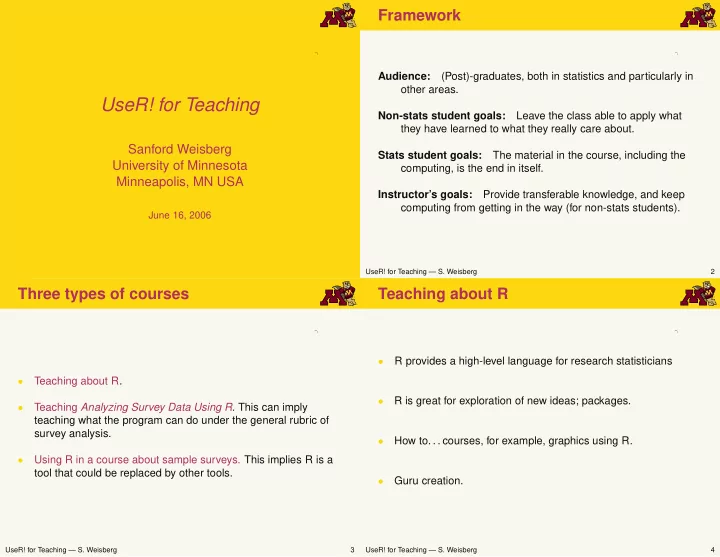

Framework Audience: (Post)-graduates, both in statistics and particularly in other areas. UseR! for Teaching Non-stats student goals: Leave the class able to apply what they have learned to what they really care about. Sanford Weisberg Stats student goals: The material in the course, including the University of Minnesota computing, is the end in itself. Minneapolis, MN USA Instructor’s goals: Provide transferable knowledge, and keep computing from getting in the way (for non-stats students). June 16, 2006 UseR! for Teaching — S. Weisberg 2 Three types of courses Teaching about R R provides a high-level language for research statisticians • Teaching about R. • R is great for exploration of new ideas; packages. • Teaching Analyzing Survey Data Using R . This can imply • teaching what the program can do under the general rubric of survey analysis. How to. . . courses, for example, graphics using R. • Using R in a course about sample surveys. This implies R is a • tool that could be replaced by other tools. Guru creation. • UseR! for Teaching — S. Weisberg 3 UseR! for Teaching — S. Weisberg 4
Analyzing [your choice here] Using R Methods primary, R incidental The program should enable, not hinder, learning methods. Easy • to say, hard to do. Common metaphors for working with the computer are: Tailor the course to match what the program does. This often • • requires compromise . browsers, iTunes, and possibly Excel. . . R is nothing like any of these and therefore is not obvious to students . Often, this is just what students want! • Students get stuck on HOW rather than WHY; memorization (is • it header or col.names or colnames ?) and inconsistency are a hinderance. “The University of Minnesota is not a technical Irregular users forget — no visual cues: a blank screen is • or trade school.” intimidating.“ . . . Tom Burk, Forestry Prof. Documentation is oriented toward the expert, not the novice • (what is an S3 and why do I care?) UseR! for Teaching — S. Weisberg 5 UseR! for Teaching — S. Weisberg 6 Textbooks Primer download statistics 1999: Applied Regression Including For January 1 – May 28, 2006, 11,000 web vists: Computing and Graphics Based on A RC and X LISP S TAT : Book and program are strongly • SPSS Primer 319 19% linked: book and program inseparable: an intellectual success, but an overall failure. SAS Primer 361 22% JMP Primer 261 16% 2005: Applied Linear Regression, 3rd Ed R/SPlus Primer 725 44% Synthesis of last edition (1985), some graphics from 1999 book, • and some new stuff Little mention of computing in the text. • Web supplements for ALR using R, S-Plus, SAS, SPSS and • No program was adequate. R/S-Plus was closest with added JMP . (google applied linear regression ). package. UseR! for Teaching — S. Weisberg 7 UseR! for Teaching — S. Weisberg 8
Does R encourage good data analysis? θ 0 + θ 1 (1 − exp( − θ 2 D )) , Deviance = 3249.84 OLS NIL 800 lowess NIL Case deletions 750 TH0 620 TH1 180 700 y TH2 6 650 If More controls > m1<-nls( y˜th0+th1*(1-exp(-th2*x)),start=start) 600 How do you find start ? How to chose the formula? What next? 0 0.1 0.2 0.3 Or, what before? How do you find out? No visual cues. D UseR! for Teaching — S. Weisberg 9 Summary > library(alr3) > m1 <- lm(LBM ˜ Ht + Wt + RCC, data=ais) > hints(m1) R works differently for different students, and R is unlikely to • work for everyone. Methods that understand lm objects: conf.intervals confidence intervals To help students: inf.index influence index plots • mmp marginal model plots Continued work on GUIs. • pod partial one-dimensional models pure.error.anova pure error analysis of variance Improved, accessible documentation (Wiki). • anova analysis of variance hatvalues hat values Continued efforts to promote consistency that might be • residual.plot residual plotting methods impossible with a commercial program but can be done in R. predict predictions/fitted values residuals residuals of various types Visual cues: • inv.res.plot inverse response plot delta.method estimate/se for nonlinear fns UseR! for Teaching — S. Weisberg 11
Recommend
More recommend